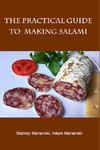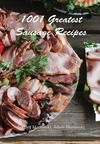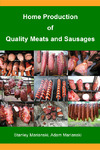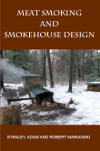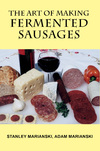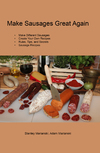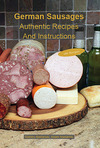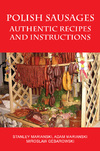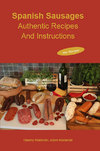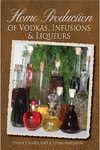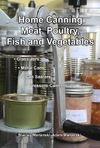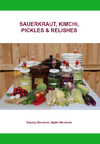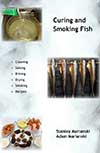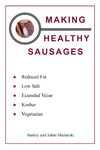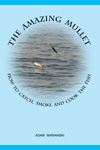Meats and Sausages
Meat Selection
Most sausages are either pure pork or a combination of pork with beef, veal, or poultry. Sausages made entirely from beef will be drier and have a harder texture. In Germany, sausages are often made from equal amounts of pork and beef; pork is more popular in Poland. Hungarian, Italian, and Spanish sausages contain mostly pork. People living in off-beaten track areas (i.e., Central Alaska) might use wild game meats like moose, bear, elk, reindeer, or rabbit. However, mixing these lean meats with pork will help achieve better texture and flavor.
Geographical locations often dictate what animals can grow in a particular climatic zone. High altitudes establish the vegetation that will grow at those levels, attracting only animals that like such a diet. Lamas have adapted well to the high Andes of South America and will be popular meat in Bolivia and Chile. Goats generally prosper well in mountainous locations. Ostrich is commonly consumed in South Africa. In Alaska, moose, bear, reindeer, and caribou are the most common animals; those meats are used for making sausages. Local customs and religious beliefs greatly influence which meats will be selected. Norway uses different meats such as moose, reindeer, mutton, lamb, goat, horse, offal (heart, liver) and blood. Norwegian sausages such as Faremorr, Sognemorr gilde, Stabbur, and Tiriltunga contain beef, lamb, and horsemeat and are heavily smoked. Sausages are made from sheep, goats, camels, horses, and other meats, but those materials will hardly appeal to most Western consumers.
The fat makes sausage tender and juicy, no fat, and the meat is dry. Not enough fat makes it dry and hard to bite. Try to fry a hamburger that is 95/5 (5% fat) and one that is 80/20 (20% fat), and you will see the difference. If you use a cut that is too lean, your sausage will definitively be healthier and cleaner, but you will miss out on the taste. Fat is also known as the carrier of flavor. It might come as a surprise, but the main ingredient in meat is water, 40 – 75%. The fat content varies widely, from 1 – 40 %; younger animals have less fat. Veal meat is considered the leanest, and pork is the fattest, although some cuts like pork loin or ham are very lean.
Religious belief plays an important factor, and many people stay away from pork, depriving themselves of eating the best quality products. The extremely religious will only use beef or lamb. Simple economics is a factor that reserves the consumption of higher-value meats for the upper class, and those less fortunate have to look at other combinations of meats.
Pork
When it comes to sausages, pork is king. Pork became popular for many reasons. Pigs:
- were the second animal to be tamed by humans. They felt secure among people, and there was food leftover.
- gained weight rapidly
- ate anything
- lived in cities and villages and ate garbage from the streets (they were Rome's first sanitation system)
- fled to the forests during invasions where they flourished and when things returned to normal, they returned back to villages
Pigs are, most importantly, cheap to raise. They tasted great, and no part of the animal was wasted. In the past, Europeans were sentimental towards cows since they produced milk and often worked on farms along with the horses. Even when a cow was killed in an accident, it was usually buried. There was a different attitude towards pigs; they were just meat to be consumed.
The animal's age is an important factor in meat quality, but it’s not the only one. The older the hog, the fatter it is. The type of food it consumes and even how much time it spends in the open air also contribute to its final taste. The fame of some of the best hams in the world depends not only on how they are made but on what pigs ate most of their lives: Original American Smithfield Ham – peanuts, Spanish Serrano – oak acorns, Italian Parma – chestnuts and whey (from the parmesan cheese making process). The diet affects especially the texture and flavor of fat, peanuts produces a softer pork fat than oak acorns.
When it comes to selecting pork meat for sausages, the majority of books and recipes mention the same word: "use a pork butt". Sure, it has the right lean meat-to-fat ratio of 70/30, and the sausage will be fine. What about a guy with a big family who buys the whole hog - two pork butts weighing 15 lbs in total, and he certainly can make some sausages, but what about the remaining 250 lbs of the meat? He should have nothing left; some of it will be eaten right away: ribs, chops, loins, and the rest can be processed to make all kinds of fresh and cooked smoked products like hams, butts, Canadian Bacon, smoked bacon, back fat, blood sausage, liverwurst, headcheese and dozens of different sausages. Pork butt contains different grades (classes) of meat and fat. Thus, an experienced sausage maker will separate them to make different sausages.
There is no substitute for pork fat; it is simply the best. Venison is lean and healthy, but why does every recipe beg for pork fat? To make it taste good. Sausage needs about 25 – 30 % of fat in it, and pork butts lend themselves as excellent choices. The pork butt (sometimes called Boston butt) is a great all-around choice. It has an ideal fat-to-lean meat ratio for sausage making. Another bonus is its blade bone is extremely easy to remove. Bear in mind that pork fat is unsaturated fat (good cholesterol), and pork lard (melted fatback) is much healthier than butter, which is saturated fat (bad cholesterol).
Beef
Beef is tougher than pork (the cow is older than a pig when slaughtered). There are sausages made entirely of beef or with beef and pork, the beef usually accounts for a smaller portion of the total. When finely ground, lean beef has excellent water-binding qualities; a fine grind can hold up to 30 % of water. That means all the natural juices will be entirely contained within. About 10 – 20 % of beef is added to pork to make certain types of sausages (i.e., Hunter’ sausage), but nothing stops you from going 100 % beef ( in Christian Thuringer, Pastrami), using lamb and beef (Merquez), or pork and veal (Bockwurst). In Muslim areas, lamb and beef will be used, and pork, beef, veal, and lamb are the meats of choice in Christian areas.
Good cuts of meat make good sausages. Trim out all gristles, sinew, connective tissue, and excess fat, and save those trimmings for later. Emulsified sausages (hot dog, bologna), headcheeses, and liver sausages need a lower grade of meat (sinews, tendons, gristles, skins, deboned meat) that is very rich in collagen. This meat when emulsified (made into a paste) will hold a lot of water, will bind fat and once when heated will form a natural gelatin which is crucial in some products for example when making headcheeses or meat jellies. Upon cooling, this gelatin solidifies and binds ingredients together. The best gelatin producers are pork skin or pork hocks/feet.
Emulsified sausages (finely comminuted) such as high-quality frankfurters usually contain more beef (40-60%) due to its excellent water-holding capacities. Cheaply produced commercial versions incorporate machine-separated meat, different trimmings, and phosphates, known for their strong water-binding properties. You can mix fresh and previously frozen meats, but there should be no more than 20-30% frozen meat.
All pork meat is well adapted for making sausages; you must know which sausage needs jowls (cheeks) and when to use fatback or head meat and skins. And those seemingly inferior kinds of meats end up in emulsified sausages such as hot dogs, frankfurters, and bologna sausages, which people consume daily. Specially designed de-boning machines scrape off every bit of pork, beef, and poultry bones to recycle every particle of meat and tendon. Then soy protein concentrate is added to boost nutritional value and bind some water added during emulsification. In some countries, the situation is so rampant that a hot dog contains only 15% of meat; the rest are fillers, binders, and flavor enhancers. But it looks presentable, has an acceptable taste, and what is most important for many is that it is reasonably priced.
Veal makes a light-colored sausage and has excellent binding properties. Mutton can also be used in sausage. It has poor water-holding properties, and many do not appreciate its distinctive flavor. For this reason, it should be limited to around 15% in any recipe.
Sausages can be made from various meats, some quite exotic, but we limit our choices to common meats. Chicken is the most popular meat consumed worldwide as it is easy to raise and can be cooked and eaten by the average family in one sitting. Other meats of value are fish, venison, and wild game.
| Meat Type | Advantages | Disadvantages |
|---|---|---|
| Chicken | Cheap, contains little fat, available everywhere. | High pH: breast 5.6-5.8, thigh 6.1-6.4. Poor fat characteristics, low-fat melting point temperature. Low myoglobin content (light meat, especially breast) produces a poor final color. Skin often contains a large number of pathogenic bacteria. |
| Fish | Cheap raw material. Easy to process. All varieties can be used, including de-boned meat. | Needs to be combined with pork or other meats. No myoglobin (white or grayish color). The final flavor is always fishy even when other meats were added. |
| Venison | Good color, good price. Popular meat in Northwestern U.S. and Alaska. | Available during hunting season. Often infected with trichinae worms. Very lean, needs some pork fat. |
Meat Color
,Meat color is mainly determined by the amount of myoglobin a particular animal carries. The more myoglobin, the darker the meat. To some extent, oxygen use can be related to the animal’s general level of activity: muscles that are exercised frequently, such as the legs, need more oxygen. As a result, they develop a darker color, unlike the breast, which is white due to little exercise. Fish float in water and need less muscle energy to support their skeletons, which is why the flesh of a typical fish is white. A predator fish that swims fast to catch other fish uses a lot of oxygen, and their flesh is darker.
Fat
There are different types of fat, and they can be used for different purposes. Hard, medium, and soft fats have textures and different melting points. Some head cheese and emulsified sausage recipes call for dewlap or jowl fat that may be hard to obtain. Belly fat looks similar and seems like a good replacement, but it is not. Belly is a soft fat, and dewlap/jowl is a hard fat. Fatter cuts from a pork butt are a much better choice that contains hard fat and meat.
Pork fat
Pork fat, particularly back fat, is preferred for making sausages as it is hard, white, and tastes the best. It exhibits different degrees of hardness depending on which animal part it comes from. Back fat, jowl fat, or butt fat (from the surface area) have a hard texture and a higher melting point. They are the best choice for making products in which we expect to see the individual specks of fat in a finished product, such as dry salami. Soft fat, like belly fat, is fine for making liver or fermented spreadable sausages such as mettwurst or teewurst. For most sausages, fat pork trimmings are fine, provided they were partially frozen when submitted to the grinding process. This prevents fat smearing due to the mechanical action of knives and grinder's delivery worm on fat particles.
Beef fat
Beef fat has a higher melting temperature than pork but is yellowish, affecting the product's appearance where discrete fat particles should be visible. Besides, beef fat does not taste as good as pork fat. If no back fat is available, use fatty pork trimmings or meats with more fat and grind them together. It is better to use cuts containing more fat instead of struggling with smearing when processing meats at higher than recommended temperatures. The meat and fat must be cold or partially frozen to decrease smearing.
Chicken fat
Chicken fat is neutral in flavor and is suited for making chicken sausages, although it presents some problems. It is soft and melts at such low temperatures that it is hard to work with. Softer fats can be used to make emulsified or liver sausages, which will become a part of the emulsified paste. For instance, vegetable oil can be successfully mixed with liver and fat when producing liver sausage.
Liver. Beef liver is ill-suited for making liver sausages, but up to 50 % of it can be mixed with pork liver. Pork liver is good, and liver is excellent.
Blood. For blood sausages, pork blood is also preferred to beef blood as it is much lighter in color.

